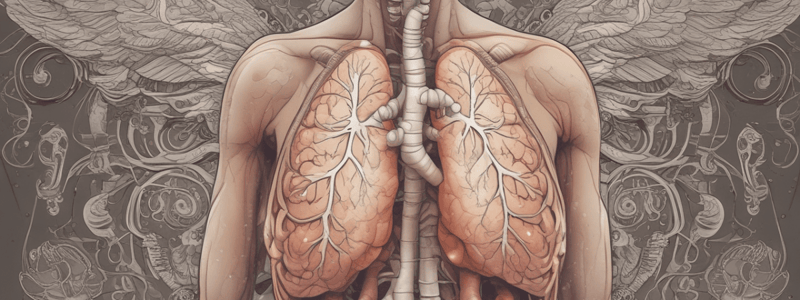Podcast
Questions and Answers
What is the primary characteristic of emphysema in the context of COPD?
What is the primary characteristic of emphysema in the context of COPD?
- Excessive secretion of bronchial mucus
- Prolonged productive cough for 3 months or more in at least 2 consecutive years
- Chronic inflammation of the airways
- Abnormal, permanent enlargement of air spaces distal to the terminal bronchioles (correct)
What is the main cause of chronic bronchitis?
What is the main cause of chronic bronchitis?
- Cigarette smoking
- Genetic predisposition
- Repeated viral or bacterial infections
- All of the above (correct)
What is the primary way to diagnose emphysema and chronic bronchitis?
What is the primary way to diagnose emphysema and chronic bronchitis?
- Echocardiogram
- Combination of history, physical findings, chest radiographs, and PFTs (correct)
- FEV1/forced vital capacity ratio
- Cyanosis and edema
What is the result of alveolar destruction in emphysema?
What is the result of alveolar destruction in emphysema?
What is a characteristic of a patient with chronic bronchitis?
What is a characteristic of a patient with chronic bronchitis?
What is the primary consequence of chronic bronchitis?
What is the primary consequence of chronic bronchitis?
What is an important aspect of therapy for emphysema and chronic bronchitis?
What is an important aspect of therapy for emphysema and chronic bronchitis?
What is a late sign of emphysema?
What is a late sign of emphysema?
What is the etiology of emphysema?
What is the etiology of emphysema?
What is the definition of COPD?
What is the definition of COPD?
What is a PFT finding commonly seen in patients with emphysema and chronic bronchitis?
What is a PFT finding commonly seen in patients with emphysema and chronic bronchitis?
What is the result of airway obstruction in chronic bronchitis?
What is the result of airway obstruction in chronic bronchitis?
What is a symptom of chronic bronchitis?
What is a symptom of chronic bronchitis?
What is the common feature of both emphysema and chronic bronchitis?
What is the common feature of both emphysema and chronic bronchitis?
What is a treatment goal for emphysema and chronic bronchitis?
What is a treatment goal for emphysema and chronic bronchitis?
What is an important aspect of respiratory rehabilitation for emphysema and chronic bronchitis?
What is an important aspect of respiratory rehabilitation for emphysema and chronic bronchitis?
Flashcards are hidden until you start studying
Study Notes
Chronic Obstructive Pulmonary Disease (COPD)
- A set of respiratory disorders characterized by increasing resistance to airflow
- Major obstructive lung diseases include chronic bronchitis, emphysema, and asthma
Emphysema (Type A COPD)
- Characterized by abnormal, permanent enlargement of air spaces distal to the terminal bronchioles
- Destruction of alveolar walls without obvious fibrosis
- Causes: cigarette smoking, air pollution, and certain occupations
- Pathogenesis: alveolar destruction caused by release of inflammatory proteolytic enzymes
- Clinical manifestations: dyspnea, weight loss, use of accessory muscles to breathe, flat diaphragm, barrel chest
Chronic Bronchitis (Type B COPD)
- Characterized by excessive secretion of bronchial mucus
- Manifested by productive cough for 3 months or more in at least 2 consecutive years
- Causes: cigarette smoking, repeated viral or bacterial infections, genetic predisposition, inhalation of physical or chemical irritants
- Pathogenesis: persistently narrowed airways due to chronic inflammation, scarring, and excessive mucus production
- Clinical manifestations: dyspnea, chronic cough with excessive sputum, cyanosis, edema, and signs of cor pulmonale
Diagnosis and Treatment
- Diagnosis based on history, physical findings, chest radiographs, arterial blood gas analyses, echocardiogram, and pulmonary function tests (PFTs)
- Classic PFT findings: decreased FEV1, low FEV1/forced vital capacity ratio, increased residual volume, and increased functional residual capacity
- Treatment implications: removal of etiologic factor, bronchodilator therapy, bronchial hygiene, graded aerobic exercise, respiratory rehabilitation, proper nutrition, and low-dose supplemental oxygen
Studying That Suits You
Use AI to generate personalized quizzes and flashcards to suit your learning preferences.




